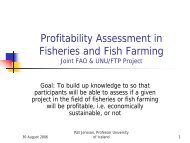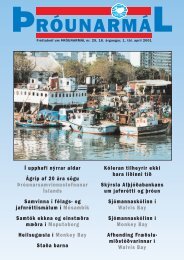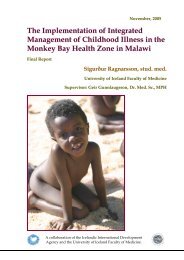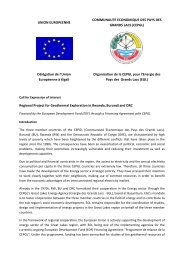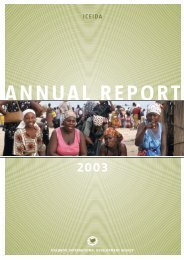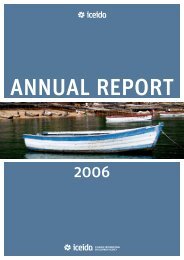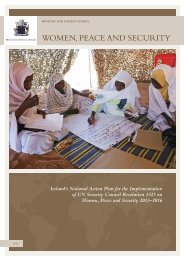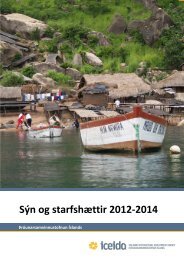Malawi: A Country Profile - Selected demo-, socio-econ data
Malawi: A Country Profile - Selected demo-, socio-econ data
Malawi: A Country Profile - Selected demo-, socio-econ data
Create successful ePaper yourself
Turn your PDF publications into a flip-book with our unique Google optimized e-Paper software.
CHALLENGES AND<br />
EXPERIENCES IN HEALTH<br />
SERVICES DELIVERY IN<br />
MALAWI<br />
Presented by:<br />
Dr. Wesley Sangala<br />
Secretary for Health<br />
Ministry of Health<br />
MALAWI<br />
September 2006
Presentation Outline<br />
A. <strong>Country</strong> <strong>Profile</strong> for <strong>Malawi</strong>:<br />
• Basic Economic and Social Data<br />
• The health situation – Demographic & Health Indicators.<br />
B. Major problems and challenges of the health<br />
sector in <strong>Malawi</strong><br />
C. Recommendations and Proposed Actions.<br />
D. Conclusion
Where is <strong>Malawi</strong>?<br />
“The Warm Heart of Africa”
Geography of <strong>Malawi</strong><br />
• <strong>Malawi</strong> is a landlocked country. Lies along the Great<br />
African rift valley.<br />
• Bordered by 3 countries – Tanzania to the N & N/E;<br />
Zambia – N/W & Mozambique – E, S/E, S & S/W.<br />
• 901 km long, 80-161 km wide. Total surface area -<br />
118,484 sq km.<br />
• 20% of the country is Lake <strong>Malawi</strong>, “fresh water lake”,<br />
3 rd largest lake in Africa with over 1,000 species of fish.<br />
• <strong>Malawi</strong> also has Mt. Mulanje – highest in Central Africa<br />
(3,000m above sea level)<br />
• Divided into 3 regions and 28 administrative districts.
A. <strong>Country</strong> <strong>Profile</strong> for <strong>Malawi</strong>:<br />
Basic Economic and Social Data<br />
• <strong>Malawi</strong> is an agro-based <strong>econ</strong>omy.<br />
• Economic growth – 5.1% in 2004, 2.1 in 2005<br />
(drought), 2006 projection - 8.4% (good<br />
harvest).<br />
• Average inflation rate – 15.4% in 2005, 11.5%<br />
in 2004, 36% in 2000. 2006 projection – 10.4%<br />
• Current <strong>Malawi</strong> Kwacha (MK) exchange rate to<br />
US $1 – MK140 (MK118.40 Dec 2005, and<br />
MK109 Dec 2004). Around 1:1 in the 1970’s!
Demographic & <strong>socio</strong>-<strong>econ</strong> <strong>data</strong><br />
Population<br />
12.3 million<br />
Male/Female 49%/51%<br />
Rural/Urban % 87/13%<br />
65s 1.3%<br />
Average h/hold size 4.3<br />
Female headed 25%<br />
Subsistence farmers 59%
Demographic & <strong>socio</strong>-<strong>econ</strong> <strong>data</strong> (contd.)<br />
GDP per capita<br />
Poverty headcount<br />
US$190<br />
65.3% of the population<br />
Literacy rate Male 74%, Female 49%<br />
No schooling 33.7%<br />
Some Primary Schooling 39.6%<br />
S<strong>econ</strong>dary Sch complete 6.3%
Points worthy noting – Mw Demog Data:<br />
• The current population has more females than males.<br />
• A large proportion is under 20 years of age.<br />
• The popn growth rate of 3.2% p/a does not match with<br />
the country’s resources. Projected popn for 2015 is 16m.<br />
A vibrant family planning prog needs to be in place.<br />
• There has been an increase in migration from rural to<br />
urban areas (11%). The Urban popn growth of <strong>Malawi</strong> is<br />
6.3% - one of the highest in the world resulting in high<br />
unemployment.<br />
• Poverty in Mw is deep, severe and widespread. 52% live<br />
on less than $1/day (below the poverty line)<br />
• About 1 in every 5 (22%, or 2.7m people) are in ultra<br />
poverty) – they cannot afford the daily recommended<br />
food requirements – esp in rural areas. One result - high<br />
malnutrition and incidences of disease.
Points worthy noting (Cont’d):<br />
• The country has poor physical infrastructure, insufficient power<br />
supply, water, telecommunication systems, and a poor road<br />
network. These adversely affect manufacturing and investment.<br />
• Low access to education with less than 20% of Std 1 children<br />
never having attended an early learning centre before enrolling<br />
in school.<br />
• Primary Education Net Enrolment Ratio has increased from 78%<br />
in 1998 to 80% in 2004. Pupil teacher ratios are as high as<br />
1:200 against a target of about 1:60 . Out of 3 million children<br />
who enter primary school only 17.5% proceed to s<strong>econ</strong>dary, &<br />
of these, only 3% get to tertiary level.<br />
• 90% of the population uses solid fuel , and only 4% has access<br />
to electricity with 11 percent urban popn having no electricity.<br />
• 2/3 of the popn has no sustainable access to an improved<br />
water sources, and this often contributes to cholera outbreaks.
<strong>Selected</strong> Health Indicators for <strong>Malawi</strong><br />
IMR (per 1,000 live births 76<br />
[104 in 2000]<br />
U5 MR (per 1,000 live births 133<br />
[189 in 2000]<br />
Total Fertility Rate 6.1<br />
[6.3 in 2000]<br />
Life Expectancy (yrs) 39<br />
[40 in 2000]<br />
Population Growth Rate 3.2%<br />
MMR (per 100,000 live births) 984<br />
[1,120 in 2000]<br />
Contraceptive Prevalence Rate 38%<br />
[31% in 2004]<br />
Attendance at birth by trained health worker 55%<br />
U5s chronically malnourished 49%<br />
Child’n btwn 12-23 mo. fully immunized 70%<br />
HIV prevalence (15-49 yrs age group) 14%
B. Major problems and challenges<br />
of the health sector in <strong>Malawi</strong><br />
• General – Health Indicators<br />
• Human Resources<br />
• Drugs, Supplies and Equipment<br />
• Infrastructure<br />
• Services Delivery
Health Indicators<br />
• The health indicators for <strong>Malawi</strong> have generally<br />
remained poor, across the board<br />
• The life expectancy has declined to 39 years -<br />
mainly as a result of HIV/AIDS.<br />
• The Infant Mortality and Child Mortality rates<br />
remain high – a reflection of the extent and<br />
impact of prevailing poverty levels and <strong>socio</strong><strong>econ</strong>omic<br />
development.<br />
• The Maternal Mortality rate of 984/100,000 is<br />
even more alarming – a reflection of poor<br />
nutrition and lack of access and coverage of<br />
maternal health care services.
Human Resources<br />
• There is an acute shortage of health workers – a<br />
“crisis”.<br />
• Average vacancy rates for nurses stand at 61%<br />
in the public health sector and 77% at CHAM<br />
(Mission) facilities.<br />
• The average vacancy rate for medical doctors<br />
stood at 62% in both MOH and CHAM instit’ns.<br />
• The current situation (staff/popn) - 1 MD per<br />
55,000, 1 Nurse per 4,100 population
Human Resources (cont’d)<br />
• Nurse staffing Norm per 230 to 250 bed Hospital<br />
- 175 Nurses, actual situation - 22 per District<br />
Hospital, and some District Hospitals do not<br />
have a qualified Medical Doctor.<br />
• The training output for health professionals from<br />
the local training institutions is still below the<br />
required targets.
A Regional Comparison of the HR Situation<br />
- Staff per 100,000 population<br />
CADRE BOTSWANA S. AFRICA GHANA TANZANIA MALAWI<br />
Physicians 28.7 25.1 9.0 4.1 1.6<br />
Nurses 241.0 140.0 64.0 85.2 28.6
Infrastructure<br />
• On average, 54% of the rural population have<br />
access to formal health services within a 5 km<br />
radius, or 84% if the urban population is<br />
included.<br />
• There are about 617 health facilities in <strong>Malawi</strong><br />
60% MOH, 25% CHAM. Only 13% of these<br />
facilities satisfy the requirements for delivering<br />
the EHP (criteria = availability of basic services<br />
and staffing).<br />
• Most facilities need maintenance, and lack basic<br />
communication systems and equipment.
Drugs, Supplies and Equipment<br />
• The sector frequently faces shortages of essential drugs,<br />
medical diagnostic equipment and surgical supplies.<br />
• There is an escalating pattern of theft of drugs and<br />
medical supplies<br />
• In some instances, the equipment is either in a state of<br />
disrepair, obsolete or not available at all for the delivery<br />
of essential health care.<br />
• In other instances, there is inadequate maintenance of<br />
medical and non – medical equipment thereby rendering<br />
it non-operational.<br />
• Currently drug allocation per capita is $1.5 - $2 only.<br />
Needed = at least $5 based on recent studies.
Financial Constraints<br />
• Inadequate public resources - at less than US$4 per<br />
capita, the health sector budget is very limited resulting in<br />
allocations not being in line with needs.<br />
• Even with other sources included (donors, Global Fund<br />
and Out-of-Pocket expenditures included), the per capita<br />
health expenditure is still under $12 – well below the<br />
stipulated EHP requirement of $17.50 in 2001 (excluding<br />
ARVs). WHO (J.Sachs’) recommendation - $34 per capita.<br />
• Limited financial access in some communities due to<br />
unavailability of free health services. This bars the poor<br />
who have no ability to pay from seeking medical care.
Services Delivery<br />
• The major causes of mortality & morbidity in Mw<br />
(malaria, diarrhoeal diseases, & Acute Respiratory<br />
Infections) are mostly preventable.<br />
• HIV/AIDS constitutes a serious threat to the country as a<br />
whole - it affects all aspects of Mw’s social & <strong>econ</strong>omic<br />
fabric. HIV/AIDS related conditions account for over<br />
40% of all inpatient admissions.<br />
• Tuberculosis once thought to be on the decline, has of<br />
late reportedly increased five-fold in the past few years.<br />
• The Disability Adjusted Life Years (DALY) remains high<br />
due to the burden of diseases and general ill-health.
Health services:<br />
(Malaria, Reproductive Health, Nutrition & HIV/AIDS)<br />
Malaria:<br />
• Malaria is reported to keep people from work on average 25<br />
days per year, or 9% of total work time.<br />
• One newspaper article recently wrote that “Malaria is Costly for<br />
Businesses”<br />
• Low income families spend more than 25% of their annual<br />
income on malaria treatment<br />
• Malaria accounts for 35% of all outpatient visits, and 43% of<br />
children under five malaria inpatient deaths. Causal factors for<br />
the high rate of malaria include low use of ITNs, delay in seeking<br />
treatment, low uptake of intermittent prophylaxis therapy (IPT), and<br />
emergency of resistance.
Services (Cont’d):<br />
Malaria:<br />
• Strategies for addressing malaria include case<br />
management and prevention. Drug policy has changed<br />
from use of SP to ACT as a first line drug for malaria<br />
treatment. Prevention focuses on increased use of<br />
mosquito nets (ITNs).<br />
• The MOH has also resorted to residual sparaying as a<br />
means for malaria control.<br />
• Over 3m nets distributed countrywide, net ownership of at<br />
least one net per household stands at 43% (71.9% for the<br />
rich quintel and 20.3% for the poorest). 100% coverage is<br />
needed. Net re-treatment rate – 59%.<br />
• Lately 1.2 m distributed of which 600,000 (50%) were<br />
distributed to the ultra poor.
Services (cont’d)<br />
Reproductive Health (RH):<br />
• MMR still stands high at 984/100,000 (1,120 in 2000. RH is<br />
therefore a high priority. More resources are required for the<br />
<strong>Malawi</strong> RH Roadmap for MMR reduction.<br />
• Cervical cancer screening (VIA) was introduced in a few sites.<br />
Wider coverage is needed.<br />
• Similarly Post abortion care (PAC) and Emergency<br />
Contraception is available in a limited number of sites. Wider<br />
coverage is needed and additional resources are required for<br />
this.<br />
• There is need for an increased and intensified in-service training<br />
in RH for different cadres of health workers.<br />
• The major strategy for addressing MMR is implementation of<br />
the MMR Reduction Roadmap including promotion and support<br />
of community initiatives.(Monkey Bay-Iceida)
Services (Cont’d):<br />
HIV/AIDS<br />
• HIV prevalence stands at 14%. The number of orphans<br />
attributed to HIV/AIDS is estimated to be over 840,000<br />
• Women of 15-24 years of age are four times at risk than<br />
the male counterparts. The 15-19 years age group is<br />
worse with nine times female risk.<br />
• The high knowledge in HIV/AIDS does not correlate with<br />
prevailing behaviour.<br />
• Strategies for addressing HIV/AIDS include treatment of<br />
opportunistic infections, promotion of condom use and<br />
other safe sexual practices, increased access to use of<br />
Antiretroviral treatment (ART)<br />
• Out of an estimated 700,000 infected people, 200,000 are<br />
estimated to be in need of ART. 60,000 people only so far<br />
are on ART. There is therefore need to accelerate the ART<br />
programme roll-out.
Services (Cont’d)<br />
Tuberculosis (TB)<br />
• The prevalence of TB increased from 523/100,000 in 1990 to<br />
551/100,000 in 2005.<br />
• Mortality increased from 78/100,000 in 1990 to 107/100,000<br />
2005. The increase largely due to HIV/AIDS.<br />
• But treatment rates increased rates from 69% in 1999 to 74%<br />
in 2004.<br />
• The main causes of high TB prevalence and mortality include<br />
low case detection, low cure rate, HIV co-infection,<br />
overcrowded unsanitary conditions. Underlying factors include<br />
limited access to diagnostic facilities, delayed care seeking,<br />
compromised immunity due to HIV/AIDS, limited coverage of<br />
health facilities and poverty.<br />
• MDR monitoring revealed an MDR rate of 2.2%.
Services (Cont’d)<br />
TB:<br />
• Currently, Cotrimoxazole prophylaxis for TB<br />
patients is being rolled out<br />
• There is need for increased support in training,<br />
TB Case finding, strengthening of laboratory<br />
services + equipment, and provision of adequate<br />
supplies of drugs, lab supplies and other<br />
consumables.<br />
• Active TB surveillance.
Services (Cont’d)<br />
Nutrition:<br />
• The National Nutrition Survey (2005) revealed that the<br />
Rate of Acute Nutrition was 6.5%.<br />
• 5% of under fives are wasted (severely malnourished),<br />
25.68% underweight, 44.1% stunted.<br />
• Up to 73% of children between the ages of 6 to 59<br />
months are anaemic.<br />
• In rural <strong>Malawi</strong>, less than 6% of children between 6 and<br />
23 months meet the recommendation for the quality of<br />
complementary food.<br />
• The underlying causes include inadequate food intake,<br />
deficient sanitary conditions, insufficient health and<br />
child care provision, low nutritional knowledge, poverty,<br />
HIV/AIDS, and low maternal education.
C. Recommendations and Proposed<br />
Actions.<br />
• First and foremost, there is need to ensure<br />
increased and improved governance. Prudent<br />
<strong>econ</strong>omic and fiscal policies need to be in place.<br />
• Ensure that there are complementary strategies in<br />
place that will ensure adequate staffing levels,<br />
equipment and other essential supplies.<br />
• Undertake a number of strategic but critical sector<br />
reforms inorder to achieve improved performance,<br />
better alignment to a changing environment and<br />
… No more “Business as usual”
Recommendations & Proposed Actions (Cont’d)<br />
• Adoption and implementation of a Sector Wide Approach<br />
(SWAp) as the main strategy for the delivery of a cost<br />
effective package of an Essential Health Package of<br />
services (EHP) that has the potential to deal with more<br />
than 90 per cent of the causes of morbidity and mortality<br />
in <strong>Malawi</strong>.<br />
• Implement Central Medical Stores (CMS) Reforms to<br />
improve its operational efficiency and address shortages<br />
of essential drugs and supplies. This includes, among<br />
other things, implementation of the CMS Improvement<br />
plan, implementation of recommendations of the recently<br />
undertaken Drugs Pilferage study, and undertaking a<br />
review of the National Drug Policy.
Recommendations & Proposed Actions (Cont’d)<br />
• Undertake financial reforms to improve financial<br />
management, accountability and procurement of goods<br />
and services. The reforms are also aimed at ensuring<br />
that the <strong>Malawi</strong> EHP is adequately financed and putting<br />
in place a sustainable financing strategy, generation of<br />
resources and removing financial barriers to access of<br />
EHP.<br />
• Improve human resource management by developing<br />
and implementing an HR Strategic Framework, an HR<br />
deployment policy, and an incentive package for hard to<br />
reach places through the Rural Incentive Programme.<br />
• Attracting back those professionals who have left.
Recommendations & Proposed Actions (Cont’d)<br />
• Address Human Resource shortages through the 6 Year<br />
HR Relief Prog which outlines 8 areas requiring external<br />
financing, implement staff retention initiatives including<br />
salary top-ups for selected cadres of critical health<br />
workers, implement a tutor incentive package as one<br />
strategy for increasing output from training institutions,<br />
contracting of medical specialists and continuation of<br />
implementation of the 6 Year Emergency Training Plan.<br />
• Support a smooth process of decentralization of functions<br />
and responsibilities to Local Authorities by strengthening<br />
capacity in the districts in various areas in preparation for<br />
the hand over of services to local authorities
Recommendations & Proposed Actions (Cont’d)<br />
• Increase access to EHP through Public/Private mix<br />
initiatives where government will collaborate with<br />
partners, initially with CHAM on the provision of services<br />
via contracting and service agreements.<br />
• Ensure that a system and package of operational, well<br />
maintained and timely replaced physical assets<br />
(infrastructure and equipment) is in place to support<br />
service delivery.
Conclusion<br />
• Whilst significant progress has been reported in various<br />
areas, health indicators for <strong>Malawi</strong> are still unsatisfactory.<br />
Therefore there is still a lot to be done inorder to achieve:-<br />
- A reversal of the negative trend in maternal<br />
decrease child mortality<br />
mortality rates,<br />
- Decrease cases of preventable diseases such as malaria<br />
- Reduce the negative impact of HIV/AIDS on the<br />
service delivery, and on people’s quality of life.<br />
<strong>econ</strong>omy, on<br />
- Sustained reductions in stunting and wasting”.<br />
• <strong>Malawi</strong> needs to continue with its efforts to achieve the goal<br />
of the MOH - to “raise the level of health status of all<br />
<strong>Malawi</strong>ans by reducing the incidence of illness and<br />
occurrence of premature deaths in the population”. The task<br />
is big but not un-surmountable.
Conclusion (Cont’d)<br />
• Despite the extremely difficult situation the MOH is<br />
operating in <strong>Malawi</strong>, some gains have been made<br />
but more remains to be achieved. Continued<br />
support is therefore sought from all in this noble<br />
task.<br />
• Whilst appreciating that there is room for<br />
improvement in internal management, accountability<br />
and governance, your support in lobbying for<br />
continued and increased support to the Developed<br />
Countries and all other partners/donors to the<br />
<strong>Malawi</strong> Health Sector, old and new, will go a long<br />
way in attaining improved health services delivery<br />
and health status in <strong>Malawi</strong>.
Thank you very much<br />
Zikomo kwambiri



